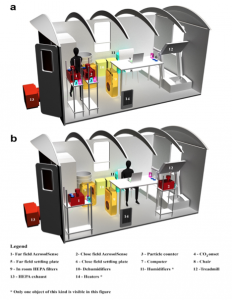New COVID Preprint out from BioBE: Preprint Link: https://www.researchsquare.com/article/rs-940891/v1 We recruited 11 participants that were diagnosed with COVID-19 and studied each for 3 days in a controlled chamber with multiple independent variables. We collected more than 2500 biological samples, particulates, and CO2 in near field (1.2 m) and far field (3.5 m) per each trial. Each …
The Finnish Institute for Health and Welfare (THL) and the University of Eastern Finland (UEF) are seeking highly motivated applicants for postdoctoral position in epidemiological analyses of microbial exposures and respiratory health. https://www.valtiolle.fi/en-US/Vacancy?id=33-290-2021 The position will focus in characterizing early-life indoor microbial exposures affecting asthma risk. The work comprises two lines of projects where one …
The Biology and the Built Environment Center (BioBE) is currently seeking a post-doc to investigate fundamental questions surrounding the role of microorganisms (bacteria, viruses, fungi archaea, and protists) in the built environment and in relation to human health outcomes. Learn more and apply here. (https://careers.uoregon.edu/en-us/job/527294/post-doctoral-scholar-in-microbial-ecology)
A new viral disease surveillance tool: Indoor dust as a matrix for surveillance of COVID-19, published in mSystems. Throughout the COVID-19 pandemic, large scale monitoring of SARS-CoV-2 has helped to prevent spread and inform public health decisions. This has largely been done through individual sampling (ie nasal and saliva sample collection) and through environmental surveillance …
Looks like a potentially interesting course… certainly topical! Information below, website here. The study of the microbiome is one of the most promising scientific and medical revolutions in recent times. It is now clear that changes in the microbiome composition (referred to as dysbiosis) are major drivers to several human diseases and public health …
So when I first dipped my toe into blogging on microBEnet (which I had just set up) on Feb 16, 2011 I had no idea that *nine* years later, I’d be furiously blogging about a global pandemic (and still in the Eisen lab). Since this is my *500th blog post* I just thought I’d reflect …
We are pleased to announce the publication of our manuscript titled “Modeling microbial growth in carpet dust exposed to diurnal variations in relative humidity using the “Time-of-Wetness” framework” in the journal Indoor Air. This work is a culmination of research investigating how changes in relative humidity impact microbial growth in carpet dust. Our related study …
In this post I’m going to share the published (relatively minor) corrections to our review on COVID19 and the Built Environment and use that as a hook to argue for the value of peer review. I’ve posted previously on our rush effort to get this paper out as quickly as possible, it was only about …
(cross posted to the UCD Microbiome SRP blog) What do you get when you combine UC Davis alumni, tomato seeds, and citizen science? That would be Project GASP (“Germ”-ination Alumni Science Project). I didn’t come up with the name, I swear. This project, sponsored and paid for by the College of Biological Sciences at UC …
So this work is a spinoff of a big project that we were involved in (but almost all of the work was done by Amy Pruden’s lab at Virginia Tech). In the larger project, they examined the genomes of over 100 clinical isolates of Legionella pneumophila, as well as 10 clinical isolates from patients during …


